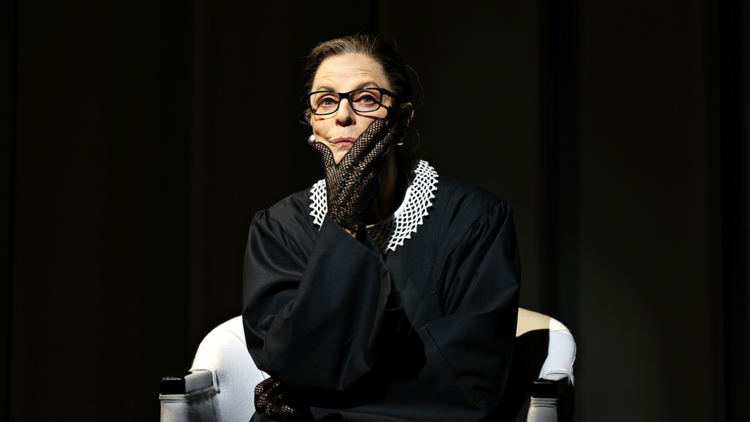RBG: Of Many, One (Sydney Theatre Company)
QPAC, The Playhouse
May 16 – May 26
You don’t have to be overly familiar with U.S. politics to recognise its major players, particularly when they have dominated the country’s mainstage as much as the late Ruth Bader Ginsburg, who served on the US Supreme Court for 27 years, as its only second woman. But beyond her position as a ‘notorious’ cultural icon, the story of RGB is an inspirational one, deserving to be told.
The legacy of the pioneering lawyer and women’s rights advocate is in safe hands with Suzie Miller’s play, presented as a 1 hour 40 minute (no interval) one woman tour-de-force by the brilliant Heather Mitchell. Commanding throughout, Mitchell displays incredible range as she equally empowers and warms us into her way of thinking and assumption that it is a woman’s duty to be where decisions are being made. The result is a fitting tribute to determination, intellect, courage and humanity.
Understated staging allows focus solely on Mitchell’s magnificence as storyteller and the operatic scale of the story she has to tell, even if its, in part tell thorough share of her inner dialogue is initially jarring in its jumps across stories and times from Bader Ginsburg’s girlhood until her death, just 45 days before the 2020 US election. Alexander Berlage’s lighting nostalgias things back into Ruth’s childhood memories of her mother’s words of advice and later works with Paul Charlier’s glorious composition and sound design to energise us into her era of superhero status in American culture after being compared to (also Brooklyn-born) rapper Notorious B.I.G.
It is this latter part of the play that brings much of its comedy through, for example, throw-away comments and observations from a modest protagonist who sees everything with clarity through the lens only of the law, which is a credit to Miller’s taut script. Indeed, there is a real craftedeness to the work’s balance of humour, heart and intellectual engagement through, for example, Bader Ginsburg’s, explanation of the reasoning behind her prophetic Roe vs Wade opposition due to its lack of basis in gender equality and therefore vulnerability to future legal attacks. Similarly, there is fascinating insight provided through her discussion of the idea that legacy played in her fiery statements of dissent and how this determined her cause and course towards the unexpected Trump presidency.
Such mentions and recollections of conversations with key political figures allows for a showcase also of Mitchell’s talent for caricature, especially of Presidents Trump and Obama, the latter in attempt to have Bader Ginsburg reconsider possible retirement in attempt to conservative-proof the Supreme Court’s bench. And along with these dynamic moments, and still with a forthright New York accent, her humility in honest reflection of RBG’s only regret of her public life, showcases her versatility, and it is easy to appreciate the rave reviews the piece received in its initial 2022 Sydney Theatre Company run.
Mitchell’s performance as the spirited trailblazer is, quite frankly, remarkable, as she inhabits the mannerisms and inflections of the story’s protagonist from her vibrant reflection of her pioneering days as a Columbia Law School law student, through to the frailty of her witty later life. Along the way of Bader Ginsburg’s fight for gender equality and reproductive rights, we are reminded of her pioneering determination and role in landmark cases, but, just as much as this, the love story of her supportive husband of 56 years, tax lawyer Martin Marty Ginsburg. This is what gives the play its power; under Priscilla Jackman’s multi-faceted direction, it’s not just about the intellectual ambitions at the core of the glory of RBG’s story, but also of its message of empowerment for women everywhere.


















